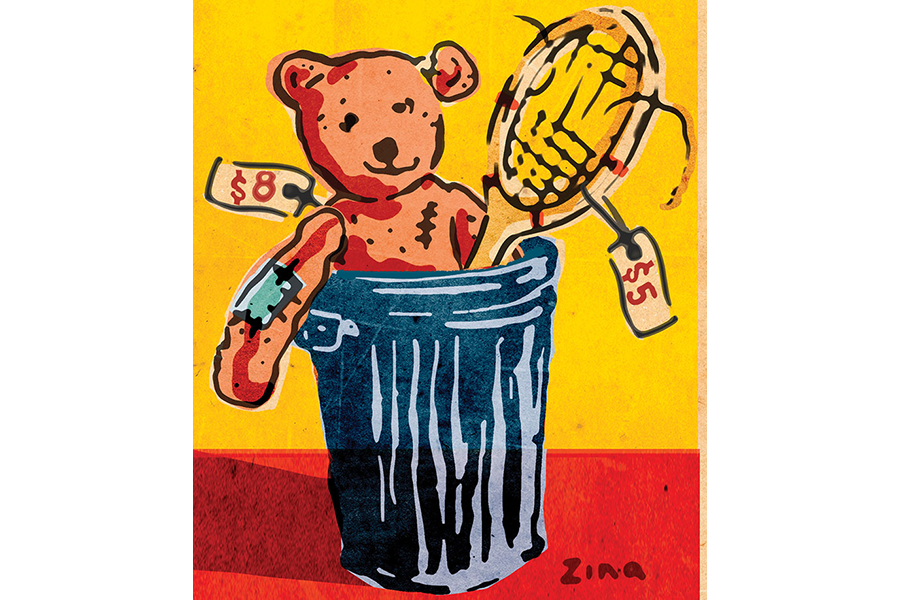The bazaar of last resort
Loading...
“Ugh! What is that?” asked my son. “The Bride of Chucky?”
Granted, the old doll I was scrutinizing was pretty scary. Her hairline had receded, her vinyl body was lumpy and sticky, and her fingers were several digits shy of a full set. Her glass eyes were especially unnerving, closing when she stood upright and flying open when she lay flat. Once she had been loved, but she had been stored in an attic for decades, where the extremes of heat and cold can be hard on a girl’s looks.
Toss her in the trash? Maybe. But first, let’s check eBay.
I typed in “1950s plastic-body doll,” clicked through a few screens, and there she was, albeit far better preserved, like a mature woman who has always used sunscreen.
“Sell one like this?” the site queried. I clicked, supplied the required caveats about condition, including defects (i.e., “Only a miracle could save this doll”), and we were in business. I uploaded photos of the disheveled beauty, and before the seven-day auction was over, I had a bid for $5.
Sold.
I tell this story not to impress you with my mercantile skills, but to prove that you can sell anything on eBay. Or almost: eBay has a list of forbidden items, but worn-out creepy dolls are not on it.
The buyer was happy: “As described!” he wrote in my feedback profile. “Super seller!” While $5, minus eBay’s take, is no windfall, the doll found a home and, I hope, a new life. Maybe she was used for parts in repairing other dolls. Perhaps those loopy eyes got fixed and once again can inspire a child’s love. It’s a win-win, if you ask me.
I also sold a selection of mismatched Barbie shoes for $3, and a bald Ken (Barbie’s dreamboat) for $5.50. But lest you think damaged dolls and their couture are my sole inventory, let me mention the torn, faded, but autographed comic strip from the 1960s, the J.F.K. campaign donkey pin missing an ear, the threadbare tablecloths. Time was when I would have trundled it all to the landfill, but once bitten by the eBay bug, I find it easy to imagine that someone, somewhere might love this 1950s clothespin bag or that bonnet hair dryer with built-in nail polish blower. Indeed, someone did.
None of it amounts to big bucks, though I have marveled at the occasional bidding war, like, for example, the one over a frumpy, puckered one-piece swimsuit, circa 1960, that would have made Brigitte Bardot look bad. And some customers, let’s face it, are odd. Recently I had a hard time convincing an Australian would-be buyer of an Irish souvenir bell that I don’t ship internationally; it’s just too much trouble. She could have flown to Ireland and bought her own bell for the price she was willing to pay. Another time, a buyer complained that the electric cord on an old radio was smudged. Really? Smudged? The cord was black. But I aim to please, so I offered a refund – and never heard from him again. I got static on that radio in more ways than one.
So why bother with the wheeling and dealing and scant profits? Because I don’t like jettisoning the past. All these trinkets and treasures once had stories. They meant something. But the people who gave them that meaning are gone, and I simply cannot rescue everything. (I can’t even sew, much less restore a doll.) So I find it gratifying that a new owner, discovered via the vast 21st-century bazaar that is eBay, will continue the story in his or her own way.
And if that person shows up on “Antiques Roadshow” with one of my knickknacks valued in the millions, well, I hope I won’t be watching.
My offspring, I know, will save even less of the trove from the family manse (recall the quip about the Bride of Chucky). So I keep on opening closets and emptying drawers, and describing the scratches, dents, and missing parts in that eBay disclosure statement. My ancestors certainly saved stuff, but they also used it. You should see all the old china and silverware.
And maybe you will. You know where.







